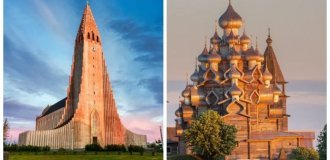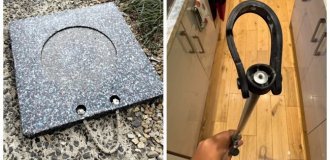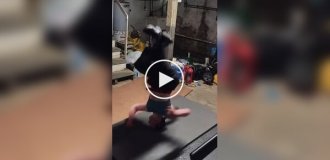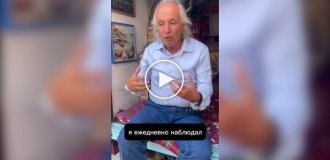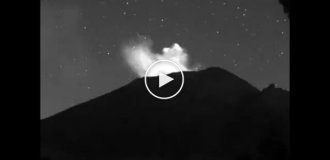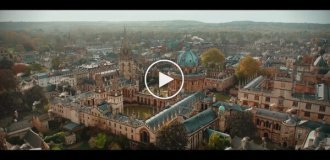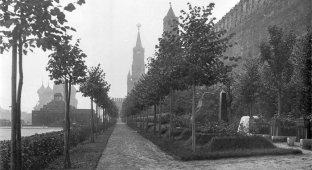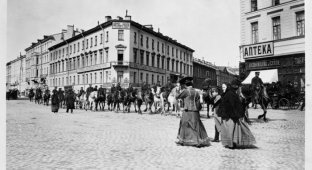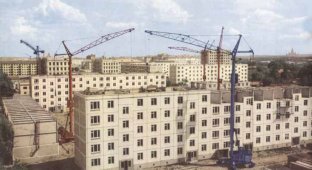Rustic Moscow of the 50s - 60s of the XX century (36 photos)
This post will show what Moscow was like during the period of its expansion in the 50s - 60s of the XX century. It was at this time that the city expanded to the limits of the Moscow Ring Road, absorbing many villages and towns that had previously been suburbs.
On Leninsky Prospekt, near the current Stroiteley Street. The grandmother and the cow did not get lost. It’s just that the villages in the southwest of the capital, which had their own way of life, were still preserved.

The future Kutuzovsky Avenue is being laid.

Here is the part of the avenue that was completed. Either the traffic rules were softer, or they turned a blind eye to this.

Courtyard near the Kievsky railway station.

Also nearby - on the Borodino Bridge. Low buildings on Smolenskaya Street and a lonely dominant... The building of the Ministry of Foreign Affairs has never had such an environment as it does now.

Nearby Rostov embankment. The wings of the "House of Architects" have not yet been completed. The Church of the Annunciation of the Virgin Mary, which is on Berezhki, has already been beheaded, but has not yet been demolished, as well as the small buildings around it.

Near the Sokol metro station. The carved patterns of private houses and the power of the newly built “space” NPO “Almaz” (it was not called that then).

In the same area. Corner of 2nd Peschanaya and Chapaevsky Lane. The wonderful house, of course, is long gone.

Novopodmoskovnaya street (now Zoya and Alexandra Kosmodemyansky). Not preserved houses; a regular ZiS-155 and a horse-drawn grain truck on a collision course.

The former Dorogomilovo and the new hotel "Ukraine".

Matveevskoye, the remaining private houses and the new Veernaya Street. In the background are Mosfilmovskaya Street and the houses of another now disappeared village, Gladyshev. Photo from 1968.

Mazilovo. Downhill skiing in the ravine of the Filka River. The Khrushchev buildings of Kastanaevskaya and Tarutinskaya streets, which are being completed here, have now been demolished and replaced with modern housing. Photo from 1963.

The picturesquely located village of Krylatskoye. Visible are Moscow State University and below - the main house of the Kuntsevo estate. 1962

Pontoon bridge on the Moscow River, which in winter connected the villages of Shchukino and Strogino. View of the Shchukinsky shore. Among the village houses and fences, the hospital of the 3rd Main Directorate of the USSR Ministry of Health, specialized in treating workers in hazardous industries (mainly with radiation), stands alone. 1960

The village of Petrovo, the slope of the beautiful Skhodnenskaya bowl dotted with ravines. 1965

Former dacha in Pokrovsky-Streshnevo (Aviation Street). The 6th tram runs from Tushino to Sokol. 1968

Barracks of the Astradam village (near the Timiryazevsky forest), before demolition. 1963

Pastoral landscape in Degunin. Only on the horizon on the right can we discern new buildings near the Korovinskoye Highway. Photo taken between 1963-1966.

6th passage of Maryina Roshcha: "Khazy" and "raspberry" have been removed, and the houses themselves are surviving. 1967

Babushkin, Comintern street. 1962

Mira Avenue, near house 173. An empty hut against the backdrop of city buildings. 1963

Sokolniki and Oleniy Val are still quite dacha. Photo from 1966.

Izmailovo. 1966

Geese on Perovo Pole (Green Avenue). Photo from 1962.

Barracks in Tekstilshchiki (1st Saratovsky Proezd). As long as the barracks are alive, “personal allotments” with vegetable gardens and mini-sheds (glaciers?) are preserved... 1962.

The Vykhino station (metro + railway platform) is just under construction. View towards Moscow. 1966

Barracks in the village of Kozhukhovo (now Trofimova Street). 1967

Printers, Shosseynaya street. Pipes in the frame are a sign of very imminent changes. The printers will also become a “dormitory area.” Photo from 1966.

The future Nagatinskaya embankment.

The last remains of the village of Cheryomushki (view from Shvernika Street). The headless village church still stands...1962.

Zyuzino old and new. I’ll add to the caption under the picture that if you mentally draw a diagonal through the mud from the lower left corner to the middle of the right edge, you’ll get modern Kakhovka Street (in principle, its route is “readable” in the picture). And the pond remained. 1964

At the Trinity Church in Konkovo. 1969

Sandy lanes. Wooden houses are giving way to new buildings. In the distance, the Hydroproject Institute is being built at the fork of the Volokolamskoye and Leningradskoye highways. 1965 (the dating on the photo itself is erroneous).

Troparevo, site of the future Vernadsky Avenue. A still from the feature film "Sunflowers", filmed in 1969.

Farmers of the village of Semenovskoye against the backdrop of new buildings on Architect Vlasov Street. 1965


